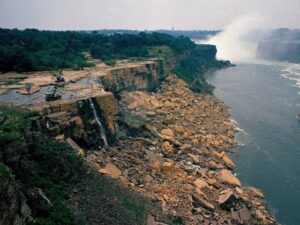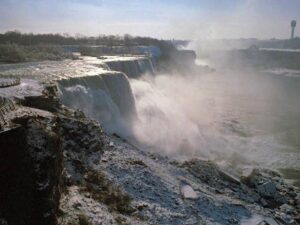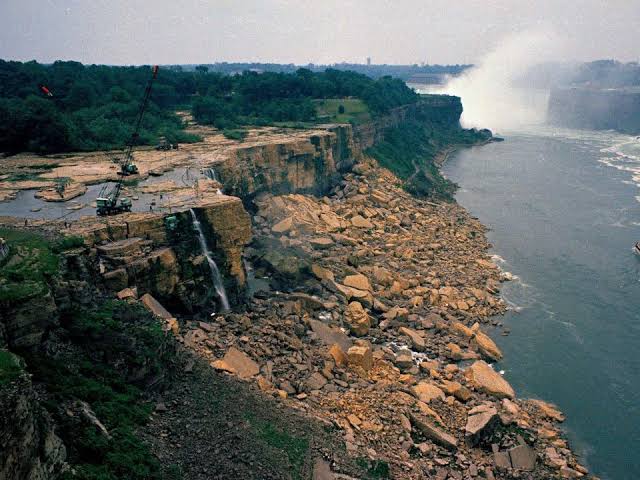Here’s what Niagara Falls looked like when it was turned off for the first time in 12,000 years
When Niagara Falls Ran Dry: The Stunning Story of Its First Shutdown in 12,000 Years
Niagara Falls is one of the most breathtaking natural wonders in the world, drawing millions of visitors each year. The sight of its rushing waters cascading down from a height of over 160 feet, creating a thunderous roar and misty spectacle, has mesmerized people for centuries. However, in 1969, something extraordinary happened—Niagara Falls was turned off.

For the first time in over 12,000 years, the mighty waterfall came to a halt, revealing a bare rock face that had been hidden beneath torrents of water since the last Ice Age. This surreal event was not due to a natural disaster but rather a carefully planned engineering project by the U.S. Army Corps of Engineers. The goal? To examine and stabilize the falls, preventing further erosion and potential collapse.
This article delves into the fascinating history, engineering feats, and unexpected discoveries that came with shutting down one of the most powerful waterfalls on Earth.
—
A History of Niagara Falls
Formation and Early Erosion
Niagara Falls was formed around 12,000 years ago during the end of the last Ice Age. As glaciers receded, they left behind massive bodies of water, one of which became the Great Lakes. The Niagara River, which connects Lake Erie to Lake Ontario, began carving through the soft rock beneath, creating the iconic waterfall that we see today.
Over the centuries, the force of the water continued to erode the falls, gradually pushing them upstream. It’s estimated that since their formation, the falls have moved back approximately seven miles. While erosion is a natural process, it became a growing concern in the 20th century, prompting scientists and engineers to take action.

The Split Between Two Nations
Niagara Falls consists of three separate waterfalls: the Horseshoe Falls (the largest and most famous), the American Falls, and the smaller Bridal Veil Falls. The Horseshoe Falls are primarily on the Canadian side, while the American Falls and Bridal Veil Falls are entirely within the United States.
For centuries, both countries have worked together to manage the falls, balancing environmental conservation with hydroelectric power generation. However, by the 1960s, concerns over erosion and rockfalls at the American Falls had reached a critical point, prompting action from the U.S. government.
Why Was Niagara Falls Turned Off?
By the mid-20th century, engineers noticed that large boulders accumulating at the base of the American Falls were changing its appearance. Rockslides and erosion threatened the stability of the falls, raising concerns that the waterfall could eventually break apart or become a mere trickle.
To address this, in 1967, the U.S. Army Corps of Engineers conducted a study to determine whether it was possible to remove the debris and prevent further erosion. The plan involved temporarily stopping the flow of water over the American Falls to allow a thorough geological inspection and decide on potential interventions.
After years of planning, the ambitious project finally commenced in 1969.
—
The Engineering Feat: How the Falls Were Turned Off
Turning off Niagara Falls may sound like an impossible task, but engineers devised a relatively simple yet effective plan: build a massive dam upstream to redirect the flow of water.
Building the Cofferdam
In June 1969, the Army Corps of Engineers began constructing a 600-foot-long cofferdam—a temporary barrier made of 27,800 tons of rock and earth. The dam was placed across the Niagara River, just above the American Falls, diverting the water flow entirely to the Canadian Horseshoe Falls.
Within a few days, the American Falls were dry for the first time in thousands of years. The transformation was astonishing: a roaring waterfall turned into a barren, rocky cliff.
—
What Was Found Beneath the Falls
With the water gone, scientists, engineers, and geologists had a rare opportunity to study the riverbed and rock formations beneath the falls. The discoveries they made were both expected and surprising.
1. Ancient Rock Formations
The exposed riverbed revealed layers of sedimentary rock dating back hundreds of millions of years. These formations provided valuable insights into the geological history of the region, helping scientists understand how the falls had evolved over time.
2. Human Artifacts
One of the more eerie discoveries was the presence of human remains. Over the years, Niagara Falls had been the site of many accidents, suicides, and daredevil stunts gone wrong. With the water removed, at least two sets of skeletal remains were uncovered, a grim reminder of the falls’ dangerous history.
3. Evidence of Erosion
As expected, the study confirmed that erosion was a significant problem. Large boulders had accumulated at the base of the falls due to rockslides, and cracks were found in some sections of the cliff face. This reinforced the need for intervention to ensure the long-term stability of the falls.
—
The Decision: To Remove or Leave the Rocks?
One of the main reasons for draining the falls was to determine whether the debris at the base should be removed to restore the waterfall’s original appearance. However, after months of study, engineers and geologists concluded that removing the boulders would be too expensive and could cause further instability.
Instead, they decided to leave the rocks in place, allowing nature to take its course. To slow down future erosion, steel bolts and anchors were installed to reinforce the rock face, ensuring that the American Falls remained structurally sound.
—
The Falls Return: Restoring the Flow
After months of study and reinforcement, it was time to bring the falls back to life. On November 25, 1969, engineers began dismantling the cofferdam, allowing water to rush back over the American Falls.
Crowds gathered to witness the historic moment as, once again, the mighty cascade returned. The thundering roar of the falls signified the end of one of the most unique engineering projects in history.
—
The Legacy of the 1969 Shutdown
The temporary shutdown of Niagara Falls left a lasting impact on both scientific research and public perception.
1. Greater Awareness of Environmental Preservation
The project sparked discussions about human intervention in natural landscapes. Many conservationists argued that while necessary, such disruptions should be minimized to preserve nature’s beauty. This debate continues today, especially in discussions about hydroelectric projects and tourism management at the falls.
2. Advancements in Engineering and Geology
The knowledge gained from the 1969 study helped improve methods for monitoring and managing erosion at waterfalls worldwide. Techniques developed during this project are still used today in geological surveys and conservation efforts.
3. A Rare Look at Nature’s Power
For those who witnessed the dry falls firsthand, it was a once-in-a-lifetime experience. The exposed rock face served as a reminder of the immense power of water to shape landscapes over thousands of years.
—
Could It Happen Again
Interestingly, there have been discussions about turning off Niagara Falls once more. In 2016, New York State proposed another temporary diversion of the American Falls to replace aging bridges over the river. However, this project has yet to move forward.
While a second shutdown remains uncertain, one thing is clear: the 1969 event was a remarkable moment in history, proving that even the most powerful natural forces can be tamed—if only for a short while.
—
Conclusion
Why Was Niagara Falls Turned Off?
The day Niagara Falls ran dry in 1969 was a surreal and unforgettable moment in history. What began as an engineering project to combat erosion became an unprecedented opportunity to study the geological past of one of the world’s most famous waterfalls.
Though the falls have since returned to their roaring glory, the images of a dry, exposed cliff remain a haunting and fascinating reminder of nature’s hidden depths. Whether for preservation, scientific research, or sheer human curiosity, the story of the day Niagara Falls stopped will continue to captivate people for generations to come.






